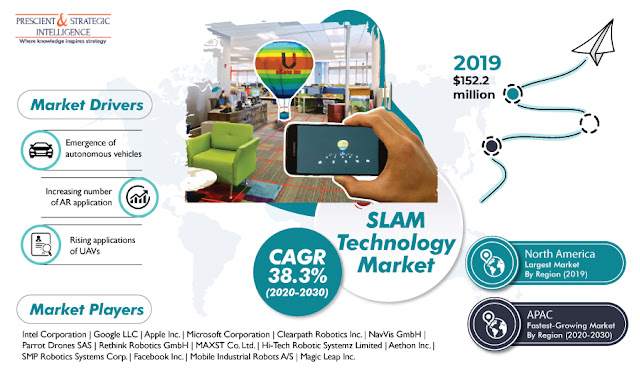Besides, the rising applications of UAVs will also drive the SLAM technology market during the forecast period. For instance, UAVs are used in the defense sector for location mapping, surveillance, reconnaissance, and intruder detection. Further, the agriculture sector uses UAVs for livestock monitoring and crop spraying. Apart from this, the UAVs are also used for aircraft maintenance, pedestrian traffic monitoring, filmmaking, and geomagnetic surveys.
Get the Sample Copy of this Report @ https://www.psmarketresearch.com/market-analysis/slam-technology-market-report/report-sample

Thus, the increasing applications of UAVs increase the demand for SLAM technology, which is used in these systems to identify the surroundings. Categories under the type segment of the SLAM technology market include extended Kalman filter (EKF), fast, and graph-based. In 2019, the EKF category held the largest market share, owing to the low algorithm complexity of EKF technology, as compared to others.
Whereas, the fast category is expected to register the highest growth rate in the forecast years, primarily on account of booming demand for 3D environment mapping. The fast technology can factorize entire posterior distribution into a vehicle path distribution and a product of landmark distributions, which can provide accurate location mapping. Geographically, North America held the largest share in the SLAM technology market in 2019.
This is due to the amplifying AR applications, escalating adoption of automated household appliances, and rising investments in robotics development. Besides, the presence of leading market players also contributed to the market growth in in the region. On the other hand, the Asia-Pacific (APAC) market is expected to witness the fastest growth throughout the forecast period. This will be due to the mounting AR applications, rising digitalization, and growing penetration of UAVs in the region.
Thus, the rising penetration of UAVs among various end-use industries and the increasing usage of AR technology will propel the market growth in the coming years.
Get the Sample Copy of this Report @ https://www.psmarketresearch.com/market-analysis/slam-technology-market-report/report-sample

Thus, the increasing applications of UAVs increase the demand for SLAM technology, which is used in these systems to identify the surroundings. Categories under the type segment of the SLAM technology market include extended Kalman filter (EKF), fast, and graph-based. In 2019, the EKF category held the largest market share, owing to the low algorithm complexity of EKF technology, as compared to others.
Whereas, the fast category is expected to register the highest growth rate in the forecast years, primarily on account of booming demand for 3D environment mapping. The fast technology can factorize entire posterior distribution into a vehicle path distribution and a product of landmark distributions, which can provide accurate location mapping. Geographically, North America held the largest share in the SLAM technology market in 2019.
This is due to the amplifying AR applications, escalating adoption of automated household appliances, and rising investments in robotics development. Besides, the presence of leading market players also contributed to the market growth in in the region. On the other hand, the Asia-Pacific (APAC) market is expected to witness the fastest growth throughout the forecast period. This will be due to the mounting AR applications, rising digitalization, and growing penetration of UAVs in the region.
Thus, the rising penetration of UAVs among various end-use industries and the increasing usage of AR technology will propel the market growth in the coming years.
Comments
Post a Comment